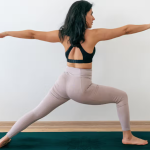You see the title on many schedules, ads and website. But what is power yoga, really? Many times it is a hotter class with a faster pace. Sometimes you may even see it as a class that incorporates push ups, squats and even weights. Out of many practices, it is far more fitness based in a board sense. However, it closely resembles a class practice of Ashtanga.
Birth of Power Yoga
To make this kind of yoga more approachable to the western world, it was named Power Yoga in the late 1990s. Power Yoga was created by two people around the same time. Bryan Krest, who resided in Los Angeles and Beryl Bender Birch, who lived in New York. Both men were very experienced in Ashtanga but wanted to take their practice to a new level and expand it for others.
Although classes can vary widely from different teachers who instruct Power Yoga, there are a few things you can count on. Power Yoga is often times thought of more as a workout. There will be less meditation and sound work. If you ever feel awkward or self conscious during the “oms” at the beginning or end of a class, then Power Yoga may be for you.
However, a power yoga class in a traditional yoga studio maybe a slower tempo and more traditional then one that might be held in a fitness center or a gym. Gyms all across the world have taken on Power Yoga to try and convey that it is exercise and not a form of meditation. Like many types of yoga, Power Yoga creates an internal heat. And like many workouts, it can build endurance, strength and flexibility.
See Also: What Is It About OM That Makes Yogis Tick?
Power Yoga vs. Bikram Yoga
Bikram Yoga is derived from Hatha Yoga and was created by Bikram Choudhury in the 1970s. His goal was to give the practice “optimum health and maximum function.” One of the trademarks that Bikram has is extreme heat while you practice. The ideal practice space for Bikram is 105 degrees. However, some studios offer Bikram but do not call it that. Hence giving them the freedom to increase the temperature to 110 degrees. Though some may like it, temperatures like these while preforming physically demanding tasks can be dangerous and must be done cautiously. As said before, Power yoga is the westernized version of Ashtanga Yoga. Other differences include:
- Bikram always consists of the same postures, two breathing exercises in the same order and in extreme heat. Power Yoga is any number of postures put together in a cohesive flow and the temperature of the room is up to the instructor who teaches the class.
- Bikram Yoga is also a trademarked practice. When you teach “Bikram Yoga” you must be certified by an official Bikram Yoga school that is approved by Bikram Choudury himself. Power Yoga is not a defined practice, so classes vary from place to place.
- Bikram dictates a way a studio must be set up, and how a teacher teaches a class. Power Yoga has no rules of this sort. So, classes can vary in length, heat and style.
- Another key difference between the two practices is that Power Yoga has traditional sun salutations incorporated into the practice. One pose molds into another and there is a consistent flow. In Bikram, there is no flow. A pose must be simply held for a certain amount of time before transitioning to the next one.
See Also: What’s the Difference Between Bikram and Hot Yoga?
Choosing a Style
Though it can be confusing at times as to what practice is what, and how they vary, there are always boundaries that a practice stays within. Yoga is a never ending circulation of energies and practices. Many take inspiration from each other and there are countless overlaps — this often creates confusion or artistic liberties that do not withhold to any particular style of practice. Yoga, no matter what kind or style an individual chooses to practice, is something that you do for yourself. You do it for you and only you. A teacher may instruct a class to perform a certain pose or breathing exercise, but no matter what class you’re in, you get to decide whether or not you perform it. Yoga is about releasing energy and gaining the centered strength in return.













